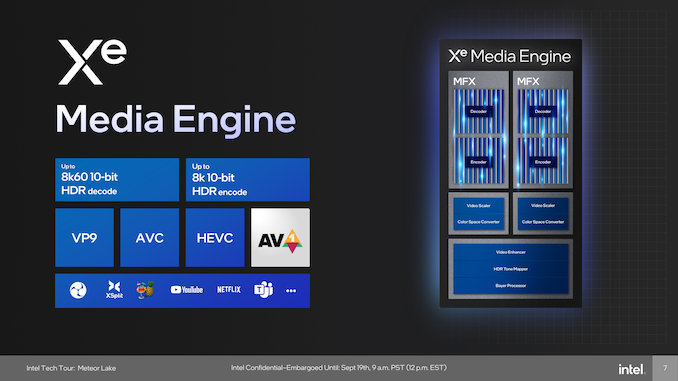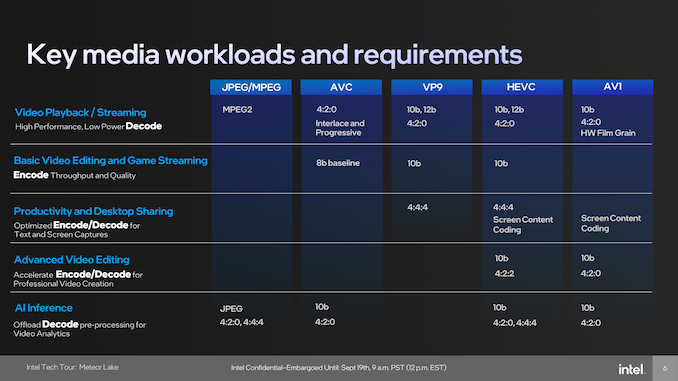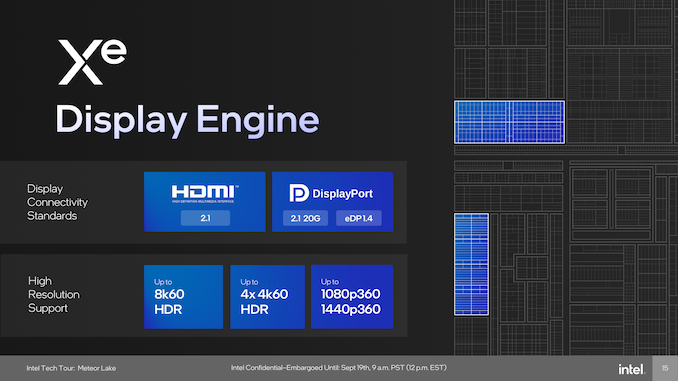Intel Unveils Meteor Lake Architecture: Intel 4 Heralds the Disaggregated Future of Mobile CPUs
by Gavin Bonshor on September 19, 2023 11:35 AM ESTSoC Tile, Part 3: Disaggregating Xe Media and Display Engine From Graphics
As we noted earlier, Intel has completely redesigned its graphics, media, and display engine for Meteor Lake and, as such, separates all three entities from each other. While we'll cover the new graphics tile next, we'll start with everything that's not part of the graphics tile. Opting for a disaggregated architecture allows Intel to not only shuffle things around from an IP perspective but also allows Intel to integrate new IPs such as cores, graphics, and I/O as and when advancements have been made at a silicon level, but the design allows unties Intel from being limited to a specific manufacturing process.
Starting things off, we have the Xe Media Engine, which is embedded within the SoC tile. Within the Xe Media Engine are two Multi-Format Codecs (MFX), designed and responsible for all the encoding and decoding tasks. Intel's Meteor Lake with Xe supports the latest codecs ranging from AV1 (decode and encode), HEVC, AVC, and VP9, with up to 8K60 HDR decode supported. For encoding, there's support for up to 8K resolutions with 10-bit color and HDR. Aiming to improve power efficiency on-chip with encode/decode workloads, having a dedicated Media Engine separate from the graphics allows Intel to find granular power savings as things are directed to the Xe Media Engine, which means the graphics tile doesn't need to be powered up to accomplish encode or decode tasks.
The Xe Media Engine provides various functionalities across a large spectrum of different video codecs. This ranges from JPEG/MPEG and AVC to the more advanced VP9, HEVC, and AV1 codecs. Designed to give Meteor Lake a solid level of computational efficiency for video processing, the Xe Media Engine balances the gaps between high-performance output and power efficiency, rendering it particularly well-suited for various applications, from real-time video streaming to high-fidelity playback. There's also support for diverse color formats and bit depths, including but not limited to 4:2:0 at 10-bit and 12-bit, which means it's versatile for video editing and video encoding and should satisfy content creator's needs.
Xe Display Engine: Also Within the SoC
Much like the Xe Media Engine, the Xe Display Engine is also found within the SoC tile on Meteor Lake. Decoupling this directly from the graphics tile and embedded into the SoC allows it to communicate directly with the Xe Media Engine, saving power and improving overall battery life. The engine supports up to four display pipes, two of which have been designed and optimized for low power consumption, further boosting overall efficiency for Meteor Lake.
Looking at compatibility, the Xe Display Engine looks to use the latest connections and ports, including native support for HDMI 2.1, DisplayPort 2.1, Embedded DisplayPort (eDP) 1.4. and even DSC 1.2a. Via these blocks, Meteor Lake can support displays up to 8K60 HDR, or up to 4 x 4K60 HDR displays, and this is on top of 1080p360 and 1440p360 too. This gives Meteor Lake substantial display and multimedia device support, including current and up-and-coming panels.













107 Comments
View All Comments
tipoo - Tuesday, September 19, 2023 - link
Is anyone at AT planning on deep diving the A17 Pro?Ryan Smith - Tuesday, September 19, 2023 - link
At the moment, no. I do not have a mobile editor to work on such projects.FWhitTrampoline - Tuesday, September 19, 2023 - link
Oh no that's bad news as Apple appears to have gone even wider with the A17 P cores than even the A14/Firestorm with decode resources on A17/P core, if the Apple promotional material is correct!Maybe Chipsandcheese will look at A17's P core design and with some Micro-benchmarks as well.
tipoo - Tuesday, September 19, 2023 - link
Yeah that's too bad, it looks like the e-cores got a bigger bump than the p-cores but they didn't advertise it with how strangely they mentioned itFWhitTrampoline - Wednesday, September 20, 2023 - link
The slide from Intel on its Crestmont E core design(Block Diagram) does not look that much different from Gracemont's block diagram and Redwood Cove(Block Diagram) core design still appears to be a 6 wide Instruction Decoder design and so Similar to Golden Cove but there needs to be more info concerning Micro-Op issue rates and other parts of Redwood Cove's core design.GeoffreyA - Thursday, September 21, 2023 - link
It's hard to see the instruction decoders being increased all that much, because of their power burden in x86.ikjadoon - Tuesday, September 19, 2023 - link
>As expected, Meteor Lake brings generational IPC gains through the new Redwood Cove cores.Redwood Cove does not have any IPC gain, I believe. Is there a citation or slide regarding this?
This will be now the third Intel CPU generation with 0% to 1% IPC gains in their P-cores.
Gavin Bonshor - Tuesday, September 19, 2023 - link
Intel confirmed to me Redwood Cove would have IP gains over Raptor Cove. When I get back (been sat at a PC a lot the last few days), I'll grab it for youkwohlt - Tuesday, September 19, 2023 - link
There's so many changes in MTL, it would make sense to just save a new P core uArch for next gen. Especially when clockspeed/watt is going up a decent amount, so it's not like perf/watt is stagnating.GeoffreyA - Thursday, September 21, 2023 - link
I think they've been following the old tick-tock system, Sunny and Golden Cove being the tocks, and Willow and Raptor the ticks. So, it's possible that Redwood would bring some proper changes.